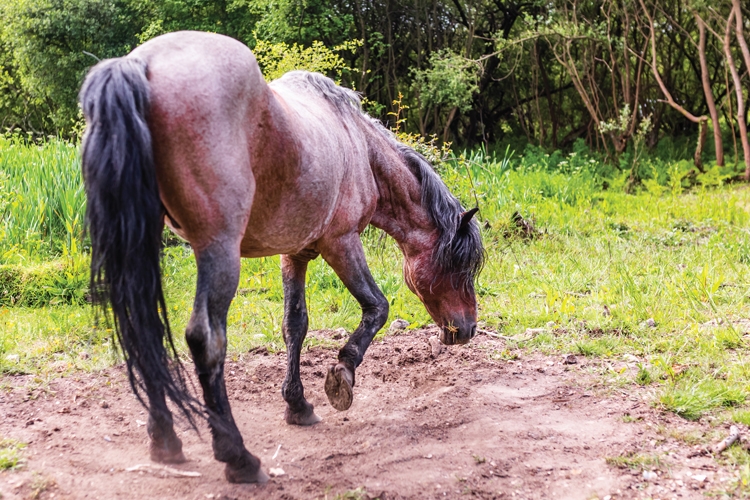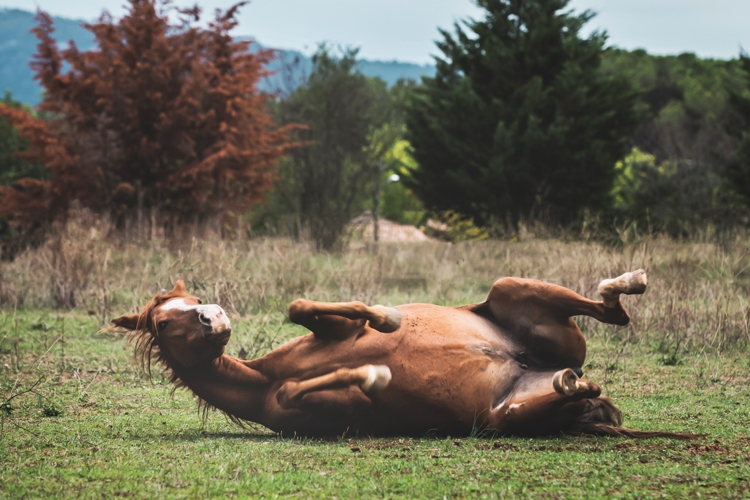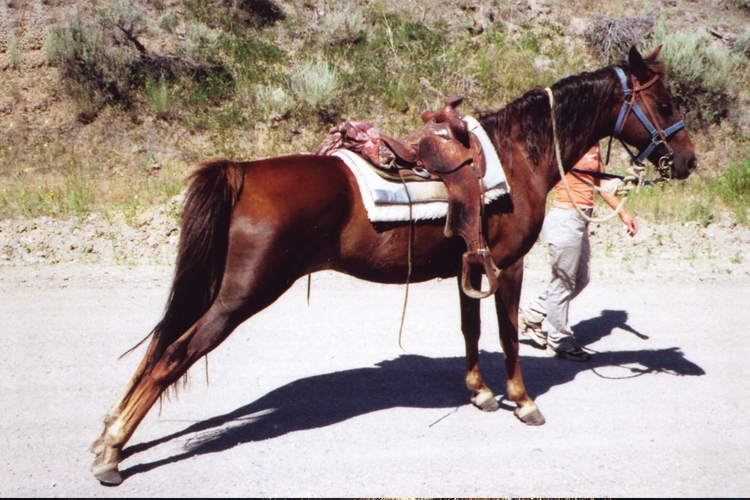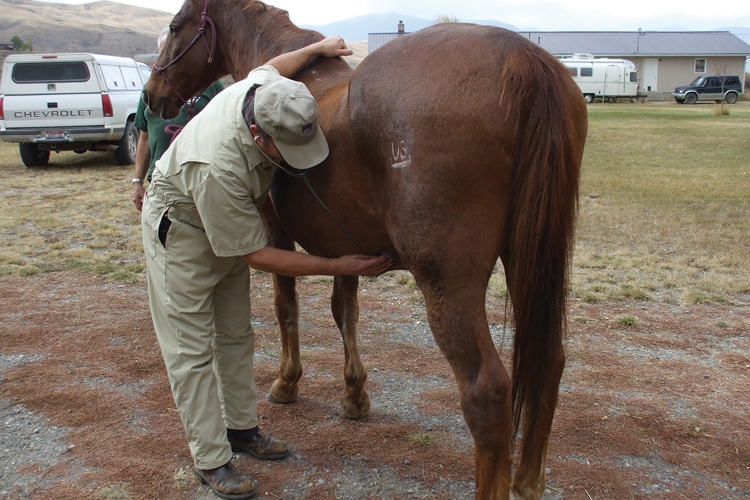
Diagnosing Colic
The term colic simply means abdominal pain. The pain may be caused by a digestive problem, irritation or blockage of the digestive tract, pain from some other internal organ, or uterine contractions in a foaling mare. The most common cause of abdominal discomfort, however, involves the digestive tract.
Signs of colic include obvious abdominal pain, which is often shown by the horse pawing, rolling, sweating, etc. If you check his vital signs, the horse will have an elevated heart rate. Mild abdominal pain may be hard to detect unless you know your horse well and can tell when he isn’t quite himself. A horse with mild abdominal pain may be just a little dull, slightly restless, or off feed. He may get up and down more than usual or spend too much time lying down and he may lie with his head tucked around toward his belly or flank.
Some horses may go off by themselves if out at pasture with herd mates and may stand in a corner away from other horses or display slightly abnormal posture. A horse will try to ease discomfort or gas pains in his abdomen by stretching or standing with head high and front legs forward, with hind feet farther back than normal. If the horse acts strange or looks dull, check his vital signs and abdominal sounds, including checking heart rate, respiration rate and temperature. A horse with a compromised gut, who is going into shock, will be sweating, but cold with subnormal temperature.
If possible, use a stethoscope or press your ear to his side to listen for gut sounds. Constant rumbling may mean an overactive gastrointestinal tract; absence of gut sounds (ominous silence, except for the gentle “whish” of lung sounds as the horse breathes) could mean a blockage or gut shutdown. In that situation, you should call your veterinarian. Keep the horse under observation. Even if he just has mild colic, it could worsen, depending on the cause.
Sometimes a horse with muscle pain, such as cramping in the large muscles of the hindquarters, shows some of the same signs as a case of colic: pawing and sweating. Any horse showing signs of discomfort may need veterinary attention, but you can often make a difference by how you handle and treat that horse until the veterinarian arrives. First, you need to determine whether the horse is suffering from colic or muscle pain due to muscle cramps. In an emergency situation, how you treat these conditions will be different, so you need to determine what the problem is.
Muscle cramping associated with exercise is often mistaken for colic because the horse is uncomfortable and may paw and sweat, but if you try to walk him (as you would for a colic case), you will make his condition worse. Thus, you need to make a quick determination regarding how to handle the situation.
If the horse is in severe pain and trying to drop to the ground and roll violently, traditional wisdom is to keep him on his feet, if possible. Violent rolling, especially if the gut is distended by gas with part of it too full and part of it empty, can cause it to flip over on itself, creating a fatal twist that shuts off blood supply to the gut. A normal horse with normal gut fill, rolling to rid himself of flies or scratch his back or relieve itchiness from sweat after a workout, will never suffer a twisted gut. Violent rolling when the gut is already compromised is what can lead to problems, so the goal is to keep the colicky horse on his feet. This is usually accomplished by keeping him moving—walking him around until the veterinarian gets there to more fully diagnose the problem and hopefully resolve it with appropriate treatment.
One of the primary techniques used by veterinarians for colic diagnosis is palpation per rectum. The veterinarian gently reaches into the rectum with a well-lubricated plastic glove/sleeve, to try to feel some of the adjacent portions of the digestive tract and other organs to help determine what is going in inside the horse.
As stated by Cid Hayden DVM, this procedure is not without risk and should never be attempted by an untrained person. The rectal tissues of a horse are delicate and bowel contractions are very strong. “The horse may be jumping around and straining against the intruding arm. This, plus the delicate tissues, could lead to injury of the rectal tissues,” he says.
“If done correctly and carefully, the risk is minimal, but there is always a chance for mild irritation and inflammation of these tissues, or even rectal tears,” explains Hayden. “Those can be very serious, requiring emergency abdominal surgery to correct.
“In a horse that has colic, the risks are greater. The horse already has abdominal pain and may have a lot of pressure due to a distended bowel. There may be an impaction, or a sore spot that would cause the horse to react if you bump into it. If you are palpating a horse for a colic examination, you could run into more potential problems, as well as more difficulty in doing the palpation itself.” he says.
“When trying to check the internal areas of the abdomen, no one has an arm long enough to feel the entire abdomen of a horse. You are usually palpating the rear one-third at best. You can’t feel everything that you need to check. You are trying to feel for an abnormality or for a normal organ that’s not where it’s supposed to be.
“In those situations, it’s not so much that you can feel what’s wrong, but the normal anatomy is not where it is supposed to be—or if it’s missing, where did it go?” says Hayden. The veterinarian may be able to interpret certain displacements.
“Some of the examination for colic, per rectum, trying to figure out what is wrong inside the horse, takes a lot of interpretation—based on what the normal anatomy would have been. In a small practice like ours (more than 100 miles from an equine hospital), if it’s a serious case where the horse needs surgical correction, this means hauling the horse somewhere else. Often, I am trying to decide early on if surgery (or a lengthier and involved diagnostic procedure) is needed, and also I have to determine if this is something the horse owner would want to do and could afford. We have to make these determinations as quickly as possible to give the horse a chance,” Hayden explains.
In a more elaborate hospital setting, colic diagnosis may include a laparoscopic examination or flank surgery, or major abdominal surgery. Other techniques available at a larger clinic may include ultrasound, as well. But out in the field or at a small clinic, tools and techniques are often limited to things like trans-rectal palpation, listening to gut sounds with a stethoscope, and doing a belly tap. The basic examination will include checking heart rate, respiration rate, capillary refill time (checking the gums), etc., to see how shocky the horse may be.
“Color of the gums and mucous membranes and other color changes can also be clues regarding whether the horse is becoming toxic from endotoxin release or other problems,” says Hayden.
Listening to the abdomen with a stethoscope can reveal the presence or lack of gut sounds, their frequency and the type of sounds. “A horse that has no gut sounds means that things are shut down, which is not a good sign,” he explains.
A belly tap (sticking a sterile needle through the belly wall to obtain fluid to examine) can tell the veterinarian several things. “We check for white blood cells and inflammatory cells, fibrin, etc. We can do other tests on that fluid to get an idea about how serious the horse’s condition might be,” Hayden says. A thorough examination of a colicky horse consists of many little bits of information to put together to see the larger picture.
One of the things the veterinarian will ask is whether the horse is passing manure. A horse with colic may pass a little manure at first and then cease if there is something serious farther up the tract that is causing blockage or shutdown. An examination of the manure may also give clues. “If it’s very dry and firm, or loose and watery, this can be an indication of problems. Sometimes the manure might have sand in it,” he says.
A history of the horse can be very helpful. “The horse may have gotten out into an alfalfa field or into the feed room and overindulged in grain, for instance. One problem we encounter fairly often is change of feed. An abrupt change, or overeating on certain kinds of feeds, or consuming moldy feed or toxic plants can lead to digestive problems and colic,” says Hayden.
“I tell people that if they have a colic situation, they should check vital signs. Every horseman should have a stethoscope and know how to use it. You also need to know what your horse’s normal heart rate and respiration rate is and how to listen to bowel sounds. Even though you might not be able to differentiate between types of breathing and types of pulses and types of gut sounds, you can count bowel contractions and gurgles—how many per minute. If you have a record (for each horse) what his normal heart rate, respiration rate and gut sound rate is, this gives something to compare to in an emergency. You can check those three things and, after you walk the horse around, check again. If those vital signs aren’t going back toward normal after an hour, call your veterinarian,” he explains. If the horse is violently colic, call the veterinarian sooner.
“Another thing a person should learn how to do—which is helpful in any serious condition—is take capillary refill. Lift up the horse’s lip, find a pink spot on the gum (it will be pink in a normal, healthy horse) and press it for a few seconds with your thumb. Take your thumb away and see how quickly it turns pink again. It should turn pink in 2 seconds or less. If it takes three seconds this indicates a little shock, four to five is mild shock, and seven seconds or longer indicates severe shock.” The gums of a shocky horse will also be dark and red/purple rather
than pink.
Treating To Relieve Discomfort
It’s generally best to wait for the veterinarian to come diagnose and treat a colicky horse, since giving a drug like Banamine (flunixin meglumine) to ease the pain may mask some of the signs and make it harder for the veterinarian to effectively assess what’s going on with that horse. If, however, it may be awhile before the veterinarian can get there, administering this drug may help keep the horse from rolling violently and damaging himself. Your veterinarian might prescribe Banamine that you can keep on hand for emergencies.
It is important to administer it correctly. Banamine is most effective when given intravenously. If you don’t know how to give an IV injection, it’s safer to give it orally rather than intramuscularly to avoid possible risk for injection site problems and serious side effects. There are oral pastes, but in an emergency, you can also give the injectable form by mouth (squirted into the mouth) to be absorbed that way. Discuss this ahead of time with your veterinarian to be prepared for colic emergencies.






